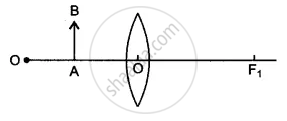Advertisements
Advertisements
Question
In a certain murder investigation, it was important to discover whether the victim was long-sighted or short-sighted. How could a detective decide by examining his spectacles?
Solution
(a) If the victim's spectacles are fitted with convex lens, the detective can conclude that the victim was long-sighted. A person suffering from long-sightedness, or hypermetropia, wears spectacles with convex lenses to correct the defect.
(b) If the victim's spectacles are fitted with concave lens, the detective can conclude that the victim was short-sighted. A person with short-sightedness, or myopia, wears spectacles with concave lenses to correct the defect.
APPEARS IN
RELATED QUESTIONS
Where should an object be placed so that a real and inverted image of the same size as the object is obtained using a convex lens?
List some things that convex lens and concave mirror have in common.
A convex lens produces an inverted image magnified three times of an object placed at a distance of 15 cm from it. Calculate focal length of the lens.
Find the nature, position and magnification of the images formed by a convex lens of focal length 0.20 m if the object is placed at a distance of:
0.15 m
What kind of lens can form:
an erect magnified image?
If an object is placed in front of a convex lens beyond 2F1, then what will be the position, relative size, and nature of an image which is formed? Explain with a ray diagram.
Out of the two lenses one concave and the other convex state which is a convergent or a divergent type of a lens. Give a reason for your answer.
Where should an object be placed in front of a convex lens so as to form an inverted and enlarged image? Will the image be real or virtual? Draw a ray diagram to illustrate your answer.

Define the principal focus of a convex lens.
Diagram shows an object AB placed on the principal axis B of a convex lens placed in air. F1 and F2 are the two foci of the lens.

(i) Copy the diagram:
Draw a ray of light starting from B and passing through O. Show the same ray after refraction by the lens. Draw another ray from B which passes through F2 after refraction by the lens. Locate the final image
(ii) Is the image real or virtual?
